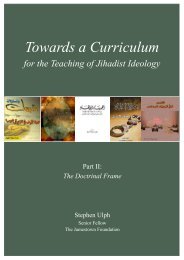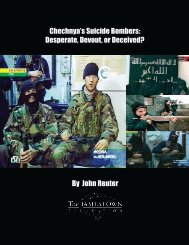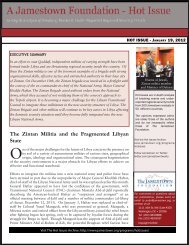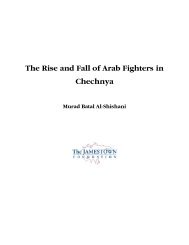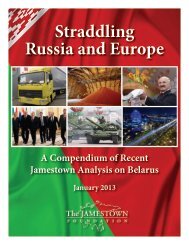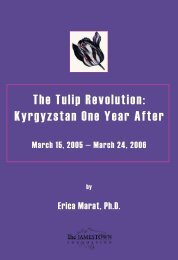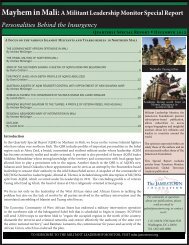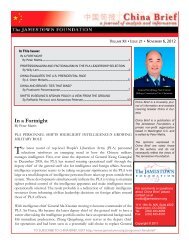By Brian Glyn Williams - The Jamestown Foundation
By Brian Glyn Williams - The Jamestown Foundation
By Brian Glyn Williams - The Jamestown Foundation
You also want an ePaper? Increase the reach of your titles
YUMPU automatically turns print PDFs into web optimized ePapers that Google loves.
more primitive nomadic lifestyle than their kin in the Crimea and were rarely counted by the Khan’s officials.<br />
Massa can be forgiven for overstating the size of the Khan's force for the Tatars' fierce appearance often<br />
alarmed<br />
Westerners who were unfamiliar with the lifestyle of the nomad. <strong>The</strong> following seventeenth century<br />
description of a Tatar contingent is typical of Western descriptions:<br />
Many looked more like gypsies than soldiers. <strong>The</strong> most wretched creatures that one<br />
could observe were the Tatars...<strong>The</strong>y are wild, raw and barbaric people and seem to be<br />
bad soldiers. In place of a flag they have horse's tails on a long pole. <strong>The</strong>y have no<br />
weapons apart from handzars and poleaxes and no music at all. <strong>The</strong>ir officers, however,<br />
had the fanciest weapons and their insigne was a spear like those carried by piggelders...<strong>The</strong>y<br />
are very revolting in their eating habits. <strong>The</strong>ir favorite tid-bit is horse<br />
meat or foal's flesh, which they toss on the fire and which, not even half-cooked, they<br />
stuff, unsalted into their mouths, so that blood runs down their chins. 20<br />
That a Westerner, used to the pageant of war in Europe could mistake the Tatars for gypsies is not surprising<br />
when one assesses the practical nature of the common Tatars' attire. A Tatar warrior usually wore an inverted<br />
sheepskin jacket known as a chapan, thick breeches, and a fur-lined hat to keep out the cold. For armor he wore a<br />
treated leather jacket or, if he were a little better of, a chain mail vest and spiked helmet. His weapon of choice<br />
was the powerful compound bow, which he could use with unparalleled accuracy while riding. <strong>The</strong> curved<br />
saber, short spear and horsehair lasso (used to unseat opponents) were also utilized with great effect by<br />
the Tatars.<br />
<strong>The</strong> Tatars were not known for their proficiency with firearms which they considered too clumsy to be<br />
used in the fast riding battles of the steppe. <strong>The</strong> Tatars of the steppe were somewhat in awe of<br />
firearms when they were first introduced to this region as can be seen by Mengli Giray's request to<br />
Russians for these weapons in his struggles with the Tatars of the Golden Horde. "Send me by the Don some<br />
pieces of artillery, for form's sake merely, the enemy will fly directly he sees them." 21 <strong>The</strong> Tatars may have also<br />
felt, as Brent puts it, "that such mechanical devices detracted from the human element of personal bravery,<br />
which should always predominate in war." 22<br />
<strong>The</strong> Tatars' choice of weapons and attire was not the only aspect of their warfare that differed from those of the<br />
West. According to Parry, "<strong>The</strong> Tatars fought in a style which, if it had ever existed in Western Europe, had<br />
long since vanished." 23 <strong>The</strong> Tatars' unique style of warfare was a product of his environment. Inured to<br />
the harsh life of the steppe herder where cattle and slave raids, sudden attacks and tribal warfare were<br />
commonplace, the Tatars considered warfare to be a way of life.<br />
Westerners used to a more "civilized" style of warfare were often appalled at the Tatars' seemingly senseless<br />
violence as can be seen by Eton's account of their tactics:<br />
<strong>The</strong> Tatar mode of fighting has no resemblance to European tactics, it is one continued<br />
scene of confusion and tumult, though it gives occasion to the display of great agility,<br />
and no small portion of a barbarous kind of skill. Alternately flying and advancing in<br />
detached parties, many kinds of contest carried on at once; the saber, the pike, and fire arms,<br />
are all employed, and they fight alike on horseback or on foot, though the former is the most<br />
common mode.<br />
6




